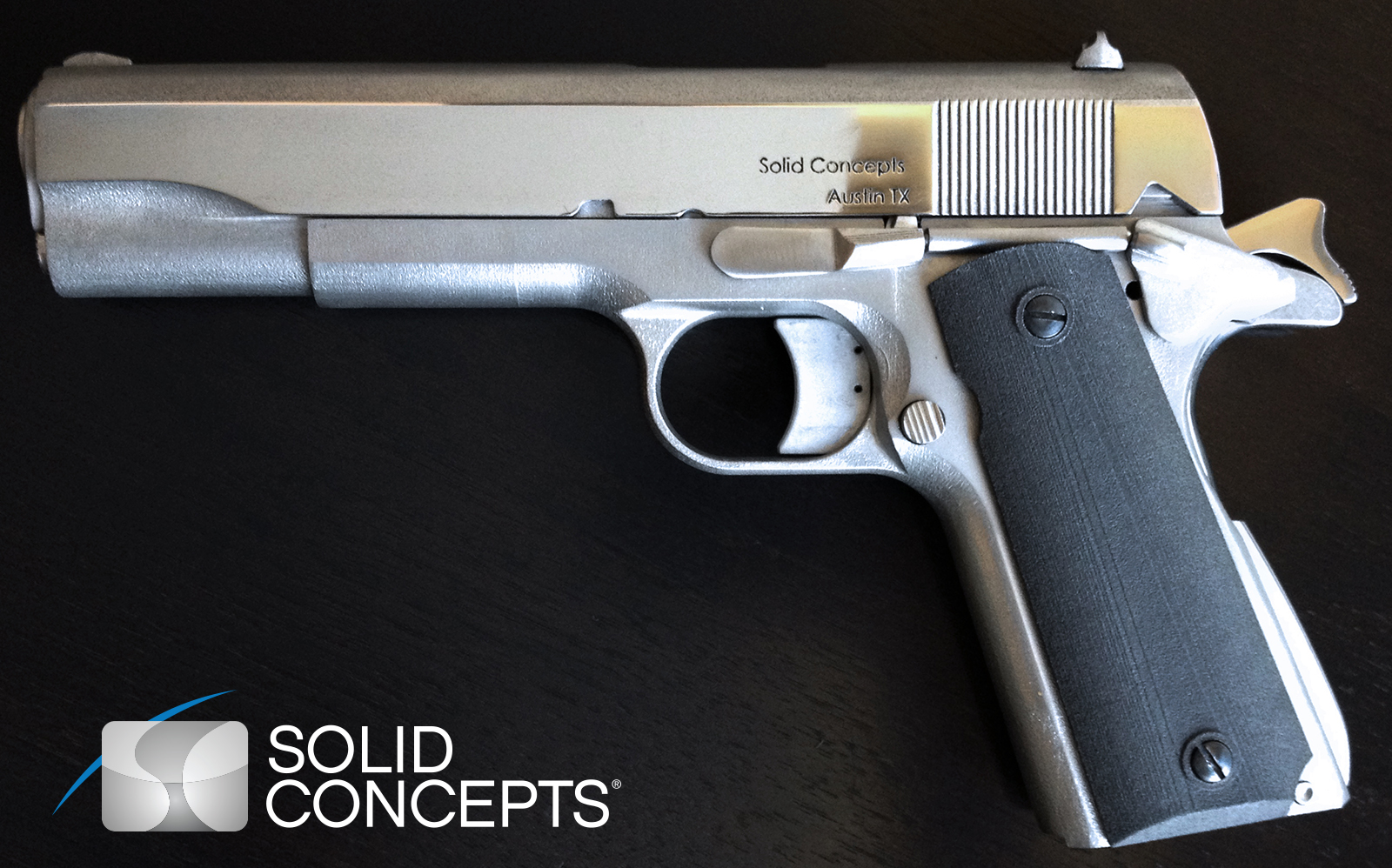Solid Concepts Uses Metal Additive Manufacturing to Build a Gun

This 1911 pistol was built using 3D printing. Courtesy of Solid Concepts.
Latest News
November 8, 2013
Gun control is a hot button issue in the wake of tragedies like Sandy Hook. Reasonable arguments from both sides of the issue are generally lost in the tumult of emotional response and counter response. Additive manufacturing (AM) has been drawn into the controversy following the successful firing of Defense Distributed’s 3D printed “Liberator” pistol. The successful test raised all sorts of concerns over the potential for AM to cause mayhem, and even prompted some political figures, such as Senator Chuck Schumer, to call for new forms of regulation to cover firearms built using 3D printing.
While the initial wave of interest over the Liberator eventually died down, worries about AM built guns continued to crop up from time to time in the form of ill-advised stunts to smuggle (empty) 3D printed guns onto planes and trains, and even into government offices. A raid by police in Manchester, England even raised the specter of 3D printed guns being manufactured illegally in the UK, before cooler heads determined the “gun parts” were actually additional parts to build or repair a 3D printer.

Throughout the 3D printed guns controversy, one fact remained that acted to soothe most concerns: materials. The Liberator and its ilk are made from plastic. The number of rounds the weapons could fire before misfiring (in potentially spectacular fashion) was fairly limited by the stresses allowed by the medium. Certainly an AM built gun could be dangerous, but so can matches in the wrong hands.
Solid Concepts, a service bureau with offices in California, Texas and Michigan, may have inadvertently raised the stakes of the 3D printed firearms conversation with its announcement that it has successfully manufactured and fired a 1911 pistol using not plastic, but metal. The company used direct metal laser sintering (DMLS) and stainless steel to construct the majority of the weapon.
“We’re proving this is possible, the technology is at a place now where we can manufacture a gun with 3D Metal Printing,” says Kent Firestone, vice president of additive manufacturing at Solid Concepts. “And we’re doing this legally. In fact, as far as we know, we’re the only 3D printing service provider with a federal firearms license (FFL). Now, if a qualifying customer needs a unique gun part in five days, we can deliver.”
Solid Concepts insists they built the weapon as an example of what AM was capable of, not as an end-around traditional firearm manufacturing.
“The whole concept of using a laser sintering process to 3D Print a metal gun revolves around proving the reliability, accuracy and usability of metal 3D Printing as functional prototypes and end use products,” says Firestone. “It’s a common misconception that 3D Printing isn’t accurate or strong enough, and we’re working to change people’s perspective.”
Intentions aside, I suspect some people aren’t going to be happy about this particular use of AM. While it’s pretty obvious to me that black marketeers are unlikely to come up with a system that costs nearly $1 million just to print out firearms, gun control advocates are equally unlikely to welcome a new method of building reliable, difficult to trace, firearms.
It seems to me the durability of 3D printed parts has already been proven by entities such as NASA, who successfully test-fired a rocket engine that contained AM parts, or by GE’s announcement that it is using AM in production parts. That begs some questions: Is this announcement more about showing off in a manner designed to invite controversy, which could lead to increased scrutiny of 3D printing technology by various regulatory bodies? Or is it just another innovative use of AM to build custom parts — say an exact replica of an antique gun’s hammer — that may not be available otherwise?
We’ve reached out to Solid Concepts for their take on whether this move could slow the progress of AM, and will update this post if they respond.
UPDATE
Rapid Ready has received a reply from Solid Concepts’ Eric Mutchler.
“We are no different than other large arms manufacturers due to our Type 07 FFL. We simply took a +100 year old design and produced it the most current metal technology available to date. This 1911 is not sitting on the edge of reason, in fact if our CNC machine shop built it the way all current 1911’s are built today it would be white noise. As far as the controversial plastic guns, our FFL has made the entire company aware and very watchful of clients trying to print plastic weapons. We do not condone that.”
Below you’ll find a video that demonstrates the 1911.
Source: Solid Concepts
Subscribe to our FREE magazine, FREE email newsletters or both!
Latest News
About the Author
John NewmanJohn Newman is a Digital Engineering contributor who focuses on 3D printing. Contact him via [email protected] and read his posts on Rapid Ready Technology.
Follow DE





